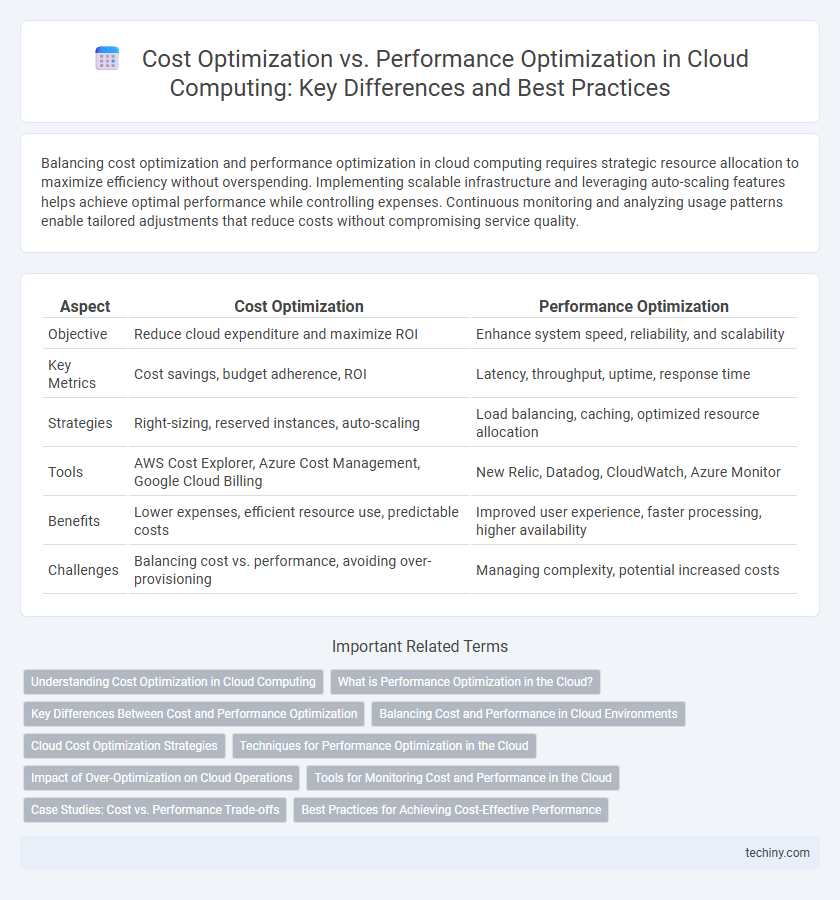Balancing cost optimization and performance optimization in cloud computing requires strategic resource allocation to maximize efficiency without overspending. Implementing scalable infrastructure and leveraging auto-scaling features helps achieve optimal performance while controlling expenses. Continuous monitoring and analyzing usage patterns enable tailored adjustments that reduce costs without compromising service quality.
Table of Comparison
| Aspect | Cost Optimization | Performance Optimization |
|---|---|---|
| Objective | Reduce cloud expenditure and maximize ROI | Enhance system speed, reliability, and scalability |
| Key Metrics | Cost savings, budget adherence, ROI | Latency, throughput, uptime, response time |
| Strategies | Right-sizing, reserved instances, auto-scaling | Load balancing, caching, optimized resource allocation |
| Tools | AWS Cost Explorer, Azure Cost Management, Google Cloud Billing | New Relic, Datadog, CloudWatch, Azure Monitor |
| Benefits | Lower expenses, efficient resource use, predictable costs | Improved user experience, faster processing, higher availability |
| Challenges | Balancing cost vs. performance, avoiding over-provisioning | Managing complexity, potential increased costs |
Understanding Cost Optimization in Cloud Computing
Cost optimization in cloud computing involves identifying and minimizing unnecessary expenses while maintaining essential services, utilizing strategies like rightsizing, reserved instances, and auto-scaling to balance resource allocation. Effective cost optimization leverages cloud cost management tools and detailed monitoring to gain visibility into spending patterns and optimize usage without compromising performance. Prioritizing cost efficiency helps organizations reduce waste, improve budget predictability, and maximize return on investment in cloud environments.
What is Performance Optimization in the Cloud?
Performance optimization in the cloud involves enhancing resource efficiency, reducing latency, and maximizing application throughput to ensure faster processing and improved user experience. It focuses on scaling computing power, leveraging auto-scaling, and selecting appropriate instance types to match workload demands while minimizing bottlenecks. Techniques such as load balancing, caching, and optimizing network configurations contribute significantly to achieving optimal cloud performance.
Key Differences Between Cost and Performance Optimization
Cost optimization in cloud computing focuses on reducing expenses by managing resource allocation, selecting lower-cost services, and eliminating waste, while performance optimization aims to maximize system efficiency, speed, and responsiveness through scaling and tuning. Key differences include cost optimization prioritizing budget constraints and usage efficiency, whereas performance optimization emphasizes computing power, latency reduction, and throughput enhancement. Balancing these approaches requires assessing workload requirements, where cost savings may impact performance, and performance improvements might increase costs.
Balancing Cost and Performance in Cloud Environments
Balancing cost and performance in cloud environments requires carefully managing resource allocation to prevent overprovisioning while ensuring adequate computing power for workloads. Implementing autoscaling and using spot instances can reduce expenses without sacrificing performance by dynamically adjusting capacity based on demand. Continuous monitoring with cloud cost management tools enhances decision-making to optimize both operational efficiency and budget adherence.
Cloud Cost Optimization Strategies
Cloud cost optimization strategies prioritize efficient resource allocation by leveraging auto-scaling, reserved instances, and spot instances to reduce expenses without compromising performance. Monitoring tools such as AWS Cost Explorer and Azure Cost Management enable real-time tracking and anomaly detection, ensuring budget adherence while maintaining service levels. Employing serverless architectures and right-sizing instances further balances operational costs with optimal workload performance in cloud environments.
Techniques for Performance Optimization in the Cloud
Techniques for performance optimization in cloud computing include auto-scaling, which dynamically adjusts resource allocation based on workload demands to maintain optimal response times. Leveraging content delivery networks (CDNs) reduces latency by distributing workloads closer to end-users. Additionally, implementing efficient load balancing and resource provisioning strategies ensures high availability and minimizes bottlenecks across cloud infrastructure.
Impact of Over-Optimization on Cloud Operations
Over-optimization in cloud computing often leads to diminishing returns where aggressive cost-cutting compromises system performance and scalability. Excessive focus on cost savings can cause resource under-provisioning, resulting in increased latency, outages, and poor user experience, ultimately driving up operational expenses due to frequent troubleshooting and downtime. Balancing cost optimization with performance metrics ensures efficient cloud resource allocation and sustained business continuity.
Tools for Monitoring Cost and Performance in the Cloud
Cloud cost optimization tools such as AWS Cost Explorer, Google Cloud Cost Management, and Azure Cost Management provide detailed insights into spending patterns and budget forecasts, enabling businesses to control and reduce expenses effectively. Performance monitoring tools like Datadog, New Relic, and CloudWatch offer real-time analytics on application performance, resource utilization, and system health to ensure optimal cloud service delivery. Integrating these specialized tools allows organizations to balance cost efficiency with high performance, maximizing ROI in cloud environments.
Case Studies: Cost vs. Performance Trade-offs
Case studies reveal that balancing cost optimization and performance optimization in cloud computing requires strategic resource allocation tailored to workload demands. Organizations leveraging reserved instances or spot instances achieve significant cost savings while maintaining acceptable performance levels for non-critical applications. High-performance workloads often necessitate on-demand or dedicated resources, demonstrating a clear trade-off between minimizing expenses and maximizing cloud infrastructure efficiency.
Best Practices for Achieving Cost-Effective Performance
Achieving cost-effective performance in cloud computing requires balancing resource allocation and workload demands through best practices such as right-sizing instances, leveraging autoscaling, and utilizing reserved or spot instances to reduce expenses. Implementing performance monitoring tools like Amazon CloudWatch or Azure Monitor helps identify underutilized resources and bottlenecks, enabling continuous optimization. Emphasizing automation in resource management and integrating cost analysis platforms ensures organizations maximize performance while minimizing cloud spending.
Cost Optimization vs Performance Optimization Infographic

 techiny.com
techiny.com